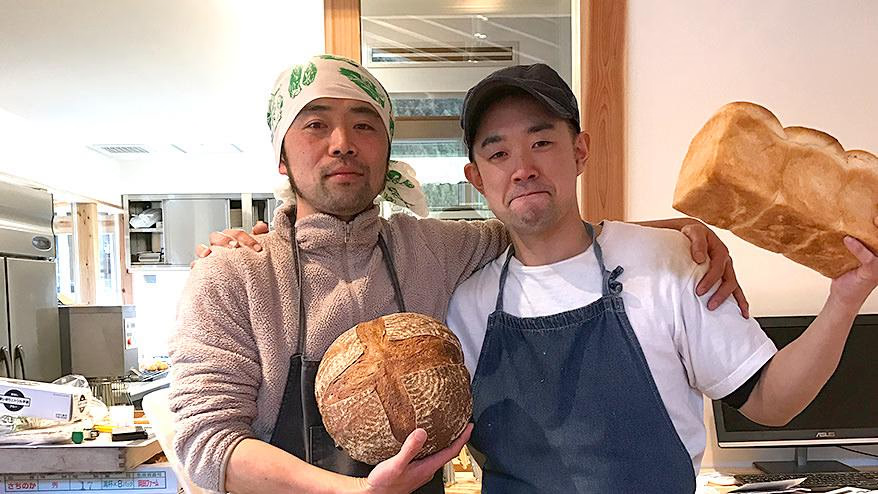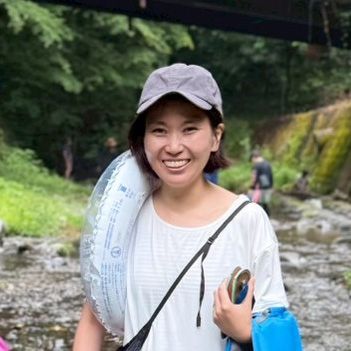こんにちは。編集長の中庭です。
先日、プロデュース部部長で、フードハブ・プロジェクトの支配人でもある真鍋から興味深い話を聞きました。
『かまパンには素晴らしいキャリアを持つパン職人がふたりいて、真逆の製法でパンを作ってきた。普通だったらぶつかるはずなのに、彼らは最初からお互いの違いを楽しんでて、自分が焼きたいパンじゃなくて、その真ん中にあるパンを作ろうとしている』
真鍋の話を聞いて、かまパンで何かとてもおもしろいことが起こっている、その様子を記録に残さねばと思い、取材させてもらうことにしました。
先日の真鍋の投稿記事では、フードハブでなぜパンを作るのかという話や、プロジェクト全体におけるかまパンの役割、パンの特徴について詳しく書かれていましたが、今回は少し視点を絞り、つくり手おふたりがから伺った「かまパンができるまで」の話をお伝えします。
ふたりのつくり手が
東京から神山にやってきた
フードハブ・プロジェクトの一環で生まれた「かまパン」。徳島県神山町で営むパン屋さんです。
かまパンの営業時間は9時から18時まで。1日に多い時に500~600個(少ない時でも400個ほど)のパンを3回に分けて焼いています。人口6000人ほどの神山町の商圏では、決して少なくないパンの量です。現時点では町外からのお客さんも多いとのこと。
そんなかまパンを支えるつくり手は、塩見聡史(しおみさとし)さんと笹川大輔(ささがわだいすけ)さん。
冒頭でお伝えしたように、真逆の製法のパン屋さんご出身のふたりです。
塩見さんは渋谷区富ヶ谷にある天然酵母パンの老舗「ルヴァン」で、いわゆる「ハード系」のパンをメインにつくってきた方です。
もともとは小学校の教師として勤めていましたが、やはり好きだった魚の研究がしたいと、沖縄の大学で海洋学を学ぶことに。その時、近所で薪窯でパンを焼く「宗像堂」というパン屋さんに出会い、バイトで働くことにしました。そこでは、みんなとても楽しそうにパンを焼いていたそうです。そんな経験を経て、「このままバイトで終わるのは淋しいな」と思い、東京に戻ったときに「東京で一番美味しいパン屋は?」と探してルヴァンにたどり着いたそうです。
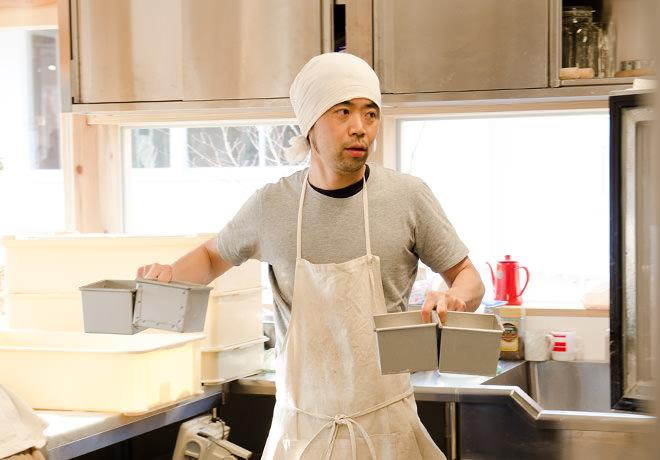
塩見聡史さん
ご自分のパン屋を開こうとルヴァンを独立するタイミングに、真鍋からかまパンのメニュー開発協力の相談を受けました。最初は迷っていたものの、これも何かの縁だと思い、参加することを決めたそう。
現在は、自身のお店の開店準備を進めながら、月の半分は神山に滞在して、かまパンのメニュー開発や日々のパン作りをされています。
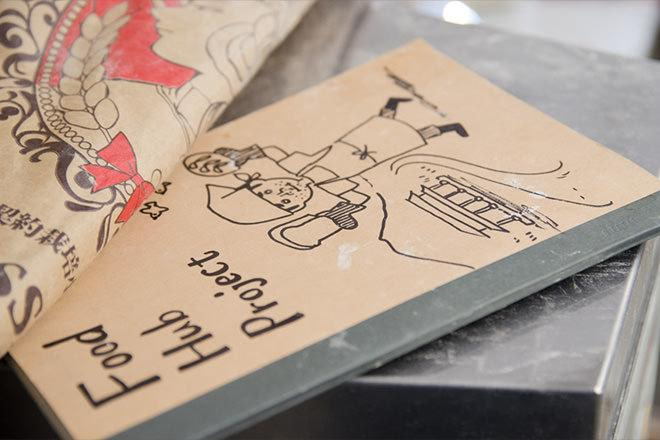
工房のかたわらには、絵本作家の奥様が書かれたという、塩見さんのイラストが描かれたあんちょこノートが。いずれ「かまパンができるまで」の絵本ができるかも?
一方、笹川さんは、お父さんがパンをつくる仕事をしていた影響で、幼い頃からパン屋さんになるのを決めていたとのこと。
高校卒業後、すぐにパン屋で勤めはじめ、パンをつくるだけでなく数値管理の仕事もされたのち、八王子にある「ブール・ブール・ブーランジェリー」というお店で、精製酵母(イースト)をメインに天然酵母も使い、ライ麦パンからクロワッサンまで、幅広い種類のパンをつくってきました。
「ブールブールのシェフがデザインもしていて、広告や売り方が上手だったんです」
パン屋は伝え方も大切だと考えていた笹川さんは、その先輩の影響もあってか「パン+ α 」で生計を立てたいと考えるようになりました。
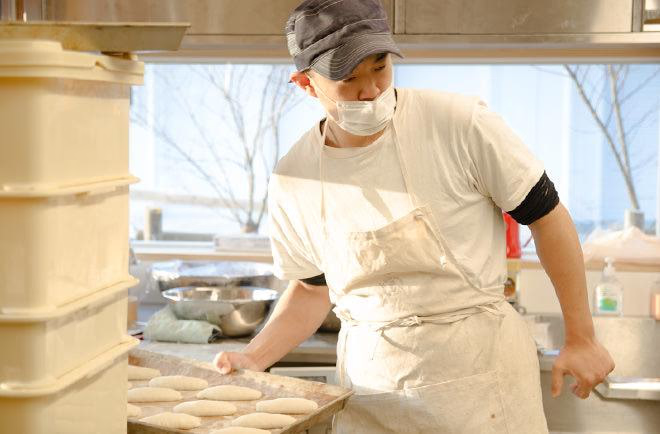
笹川大輔さん
やがて独立を考えはじめ、今後どんなパンをつくりたいのか迷っていた時、かまパンの求人記事に出会いました。以前から神山で起こっていることに興味があった笹川さんは、その記事をきっかけに面接へ。株式会社フードハブ・プロジェクトに共同出資しているモノサスの周年記念パーティーにも参加してみました。
「林さん(株式会社フードハブ・プロジェクト代表 兼 モノサス代表)の『地域に受け入れられたら成功するし、ダメだったら退場するだけ』という言葉や、真鍋さんの『暮らすように働く』という言葉に、何の違和感もなかったんです。理解しようとしたわけではなく、すーっと入ってきた。自分の中でもやもやしたものが形になって、見えてきたんです 」
「東京よりもこっちの方がビジョンをかなえる可能性が高い」と考えた笹川さんは、ご家族で神山に移住することを決意しました。
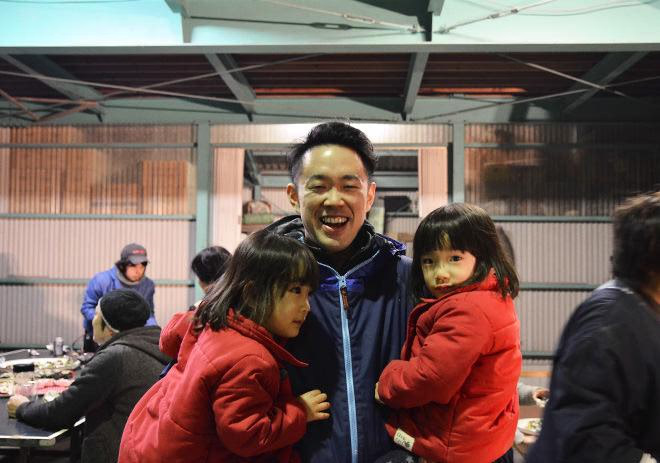
フードハブ農業長の白桃さん宅の倉庫で行われたパーティにご家族で参加していた笹川さん。両手に抱えているのは双子の娘さんです。お子さんたちも保育園から帰るとかまパンのパンをおやつにしているんだとか。
たがいの違いを楽しみながらパンをつくる
ふたりがバディになるまで
天然酵母のパン屋さんと、イースト中心のパン屋さん。
真逆なパン屋さん出身のふたりが一緒にパンを作るなんて、不安はなかったのでしょうか。
まずは笹川さんに聞いてみました。
「ルヴァンというと硬派なパン屋さんというイメージがあったので、塩見さんも難しい人かな?イーストに理解のない人かな?と思って、ちょっと緊張していました 」
一方、塩見さんは、
「笹川さんとは逆に、ぼくは天然酵母パンしか知らなかったので、バカにされないかなぁとか、笹川さんは若い頃からパン一筋の人だと聞いていたから怒られないかなぁと不安でした。あとは、ぼくは神山に月の半分通うけど、笹川さんは移住という違うスタンスでの関わり方なので、その辺がうまくいくのかなと 」
とのこと。ふたりとも、それぞれ不安を抱いてかまパンの立ち上げに臨みました。
実際にふたりでパンをつくり始めたのは、2017年2月10日の町内限定オープンの一週間前でした。
実はふたりが会うのもその時が 2 回目。かまパンの工房に入るのも初めてですし、機材もその時初めて使うものばかり。パンの作り方は機材によって大きく左右されるので、その特徴を見極めていかないといけません。
慣れない環境で、初めて一緒にはたらくメンバーで、しかも超短期間で「神山のパン」となるかまパンをかたちづくらなければならないミッション。
「ここで失敗したら、東京からきた意味がない」
とふたりは思ったそう。東京のパン屋で経験を積んできたふたりが、神山で受け入れられるのかどうか、プレッシャーは大きいものでした。
ふたりの腕が最初に試されたのが、町内オープン二日前におこなわれたフードハブチーム内での試食会です。
試食会では、ひとつのパンに対して天然酵母で作ったものとイーストで作ったもの、それぞれ用意しました。
それをみんなで食べ比べ、食パンは天然酵母で、コッペパンはイーストで、などとパンごとにメインの酵母をどちらにするか決めながら、「神山のパン」となるかまパンの方向性を探っていきます。
その方向性をもとに再度試行錯誤を重ね、2日後に町内向けオープンへと漕ぎ着けました。かなりハイスピードな展開です。
そんな時間とクオリティとの戦いの中、気づけば打ち解けていたというふたり。
今ではすっかり「バディ」といった感じで、お互いの製法や考え方の違いを楽しみながらパンを作っています。
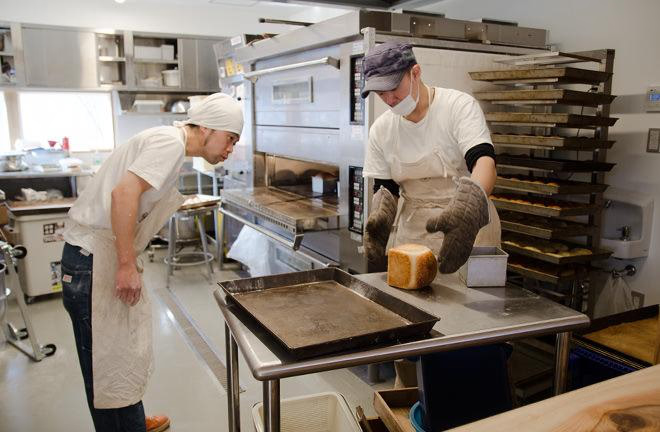
食パンの焼き加減を一緒に確認している様子
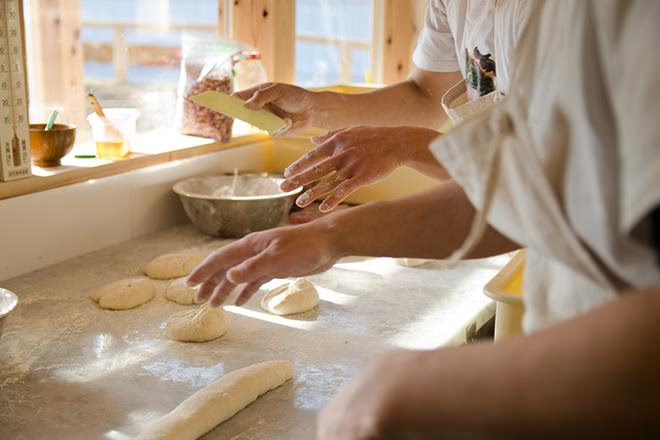
分割したバゲットの生地をふたりで成型
例えば、取材中にこんなシーンがありました。
塩見さんがフォカッチャの生地を分割していた時のことです。
これまでは分割した生地を一度番重にいれて寝かせていましたが、その日、塩見さんはルヴァンでの経験をもとに直接天板に乗せていくことを提案。普段と違うやり方でしたが、「やってみましょう!」と笹川さんは言い、ひとつ工程を短縮することができました。
忙しいパン屋さんにとって、作業の効率化は切迫した課題。しかも、塩見さんがいない時は笹川さんがひとりで厨房をきりもりしなければなりません(現在、パンのつくり手の採用活動中です)。こういった工夫の積み重ねが、かまパンの運営にとって大切なことなのです。
どちらかが「こういうのどうですか?」と言うと、
もうひとりは「あ、そんなのあったんだ!やってみましょう!」と返す。
そんな調子で、お互いのやり方の違いを否定するのではなく、まずは受け入れ、試してみるふたり。
「ふたりだからできるんです。ひとりだったら失敗すると混乱するかもしれないけど、ふたりだったらその時一緒にアイデアを出し合えばいい」
こんなやり方があるよ、こっちのやり方でもいいね、そんな風にお互いのアイデアを提案しあって、新しいものを作り出す。ミュージシャンがセッションしているようなライブ感に溢れていて、ふたりでパンを作っている時間がとても楽しそうでした。
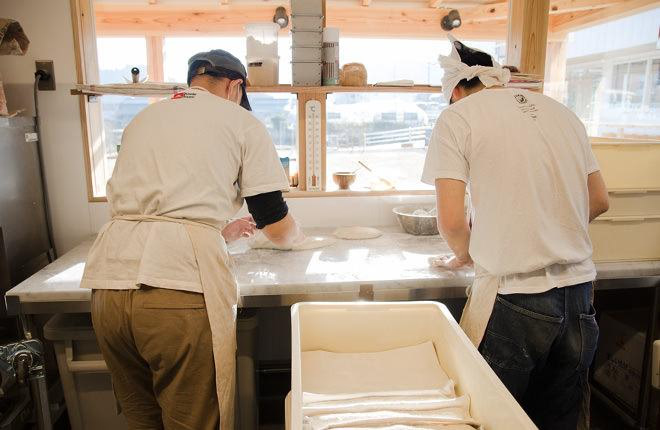
朝日を浴びながら、肩を並べて米粉バゲットを成形する笹川さんと塩見さん
そんなバディなふたりが作り出す神山のパンとは、どんなパンなのでしょう?
「神山にあったパンを作ろうと思ったら、真ん中だったんです」
と塩見さん。
パンの製法に関しては真逆だった彼らが「神山のパン」を追求する中でたどり着いたのは、それぞれが作りたいパンではなく、ふたりの間にあるようなパンだったとのこと。
「かまパンのミッションは“神山のパン”をつくることです。ぼくたちは、これとこれをかけ合わせたらどうなるか、というやり方をしています。自分の主張をしたところで、それは神山のパンではないと思うんです」
そう言う笹川さんは、神山に塩見さんが来ている時は、できるだけ好きなようにやってもらえるように心がけていて、塩見さんがいない間も「塩見さんだったらどうするかな?」と考えながら、パンを作っているそう。
「自分の流れでやってしまうと全然おもしろくないから」だと笹川さんは言います。
自分のパンではなく、完全に相手のパンでもない、自分と相手の間にあるパン。
なんだかふたりの関係性が現れたようなパンです。
それではこれから、ふたりの真ん中にある、かまパンの「パン」について具体的にご紹介します。
神山の「日常」のパン
「かまパンってどんなパンですか?」
笹川さんに伺うと
「日常のパンです」
という答えが返ってきました。
日常のパン。
それは毎日食べられるパンであり、誰かががおいしいと言ったからおいしいのではなく、生活に根ざしたパンとのこと。
「たとえば東京のパンって、ファッションになってしまったものが多いんです。もちろん個性もあるけど、日常ではないというか。値段が高いだけではなく、食感やボリュームがありすぎると、毎日食べられる手軽さがなくなってしまうんです。
誰かがおいしいと言ったから選んだもの 、そういうパンが多い気がします。
日常のパンって、近所の小学生が放課後に50円握りしめて買いに来たおやつだったり、歯医者さんの帰りに買ったパンだったりすると思うんです」
かまパンで働いていると、誰がどんな風にパンを食べているのか情景が見えやすいし、見えると嬉しい。ふたりはそう言います。
そんなかまパンの「日常のパン」の代表格が食パンです。
食パンの、もっちりしっとり、
あまくてすっぱい秘密。
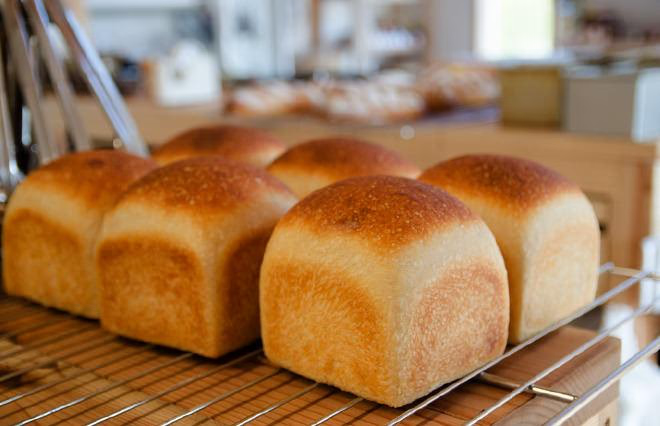
一斤300円。スーパーの食パンを買い慣れた人にとっては安くなく、パン屋でよく買う人にとっては高くないかもしれません。
毎日食卓にあっても飽きない、ごはんのように食べられるパン。持ってみるとずっしり重く、噛み締めるともっちりしていて、甘さとすっぱさが口の中に広がります。
「食パンはふたつの種からできてるんです」
そう塩見さんは言って、「レーズン種」と「自家培養発酵種」をみせてくれました。
「 “レーズン種” は、水とレーズンだけで発酵させた “レーズン液” に小麦を継ぎ発酵させたものです。ふくらむ力はイーストに比べて弱いですが、その分もっちりした食感になります」
少し味見させてもらうと、甘くてすっぱい。
種そのものの甘さがあるので、食パンに使う砂糖の量は、通常のものの半分以下の量だそうです。
もっちり感も、この種の影響なんですね。
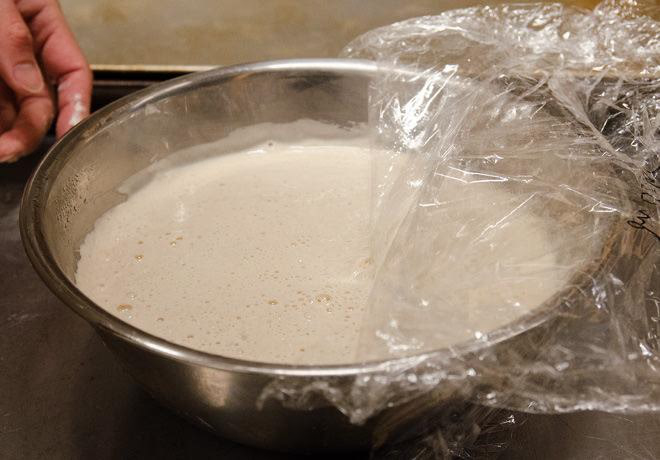
レーズン種。レーズン液に一度だけ小麦を継いだ状態。発酵により生じたガスの気泡がひろがっています。
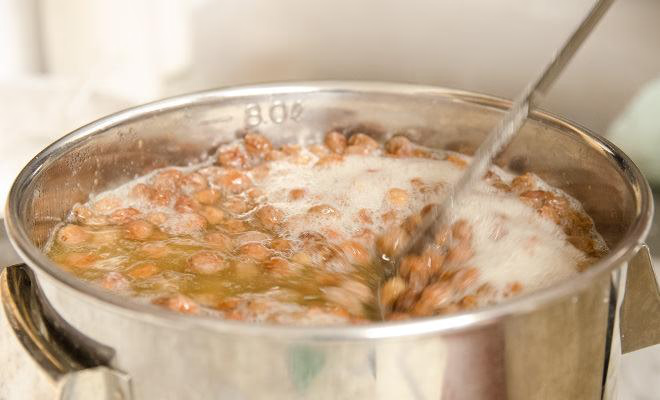
発酵中のレーズン液のようす。容器の蓋を開けると、レーズンの華やかな匂いがふわっと広がりました。表面にレーズンが浮かびあがり、泡がぶくぶくしています。新しい酸素を供給し、発酵を促進するため時々おたまで底の方からかき混ぜているそうです。少しだけ味見させてもらうと、酸味と甘さが口の中に広がって、「食べてもおいしい酵母」でした。
そして食パンに使われるもうひとつの種、「自家培養発酵種」。もともとはレーズン液の酵母と小麦で発酵させていますが、その後は小麦粉を継ぎ足して、小麦粉に付着している酵母と、糖分で発酵させています。水と小麦粉を継ぐことで種に養分をあたえ、育てていく種です。
いつまで継いでいくんですか?と質問すると
「ずっとです。ぬか床のように、永遠に継いで行きます」
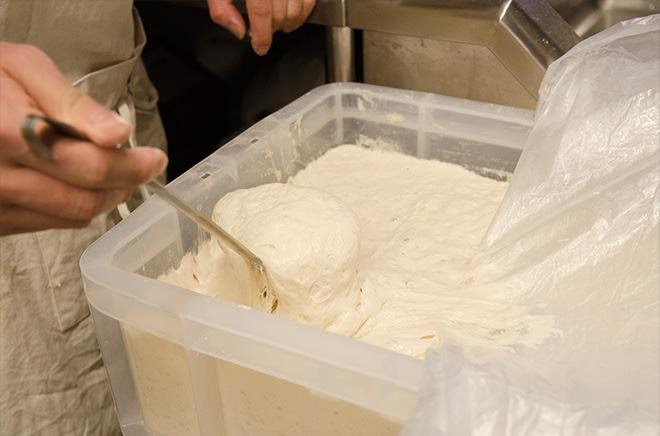
嗅ぐと、ヨーグルトのようなすっぱい匂い。
聞けば、乳酸菌と酵母が共生しているそうです。
「ここの空気中に漂う菌も、味として出てきます」
と塩見さん。
自家培養発酵種は、神山の空気中に含まれる乳酸と共生したり、空気中にただよう酵母を取り込みながら、神山にしかない味になっているとのこと。これら「レーズン種」と「自家培養発酵種」を組み合わせた種から、もっちりどっしり、甘くてすっぱいかまパンの食パンができているんです。
ちなみにもっちり感の秘密はもうひとつあります。それは「湯種」です。
前日のうちに一部の小麦粉を熱湯で茹で、でんぷんをα化させた「湯種」を、生地を混ぜ込む時に追加すると、もちもち・しっとりが長続きする食パンになります。
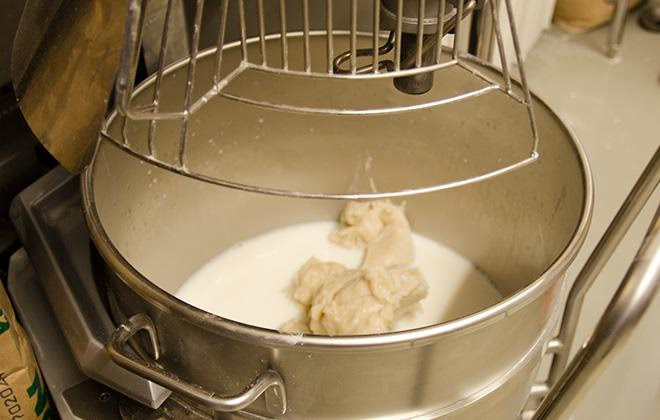
ミキシング時に湯種を追加します。
「トースト食べますか?」
そう言ってオーブンから取り出された、焦げ目がしっかりついた熱々のトースト。おふたり激推しの「トーストの美味しい食べ方」を教わりました。
まずは焼いたパンをふたつに割って、
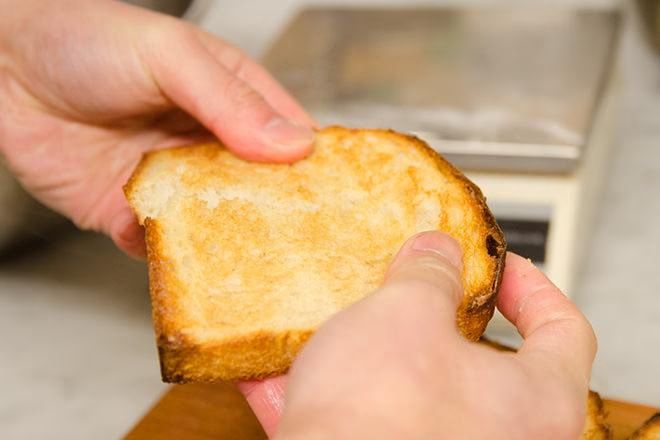
片方は白ごま油をたっぷりつけて、ちょっとだけ塩をふって食べます。
(黒ごま油だとパンの風味が消されてしまうので、あくまで白ごま油というのがポイントです。)
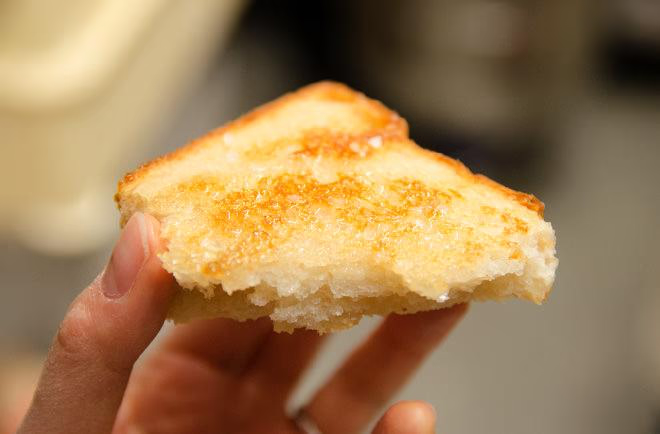
残り半分は冷たいバターをかたまりのまま熱々のパンに乗せていただきます。
普通だったらバターを塗って溶かした状態でいただきますが、あえて「バターはかたまりのまま」で置き、熱々のパンと冷たいバターの温度差と食感の違いを楽しむという、なんともツウな食べ方を教えてもらいました。
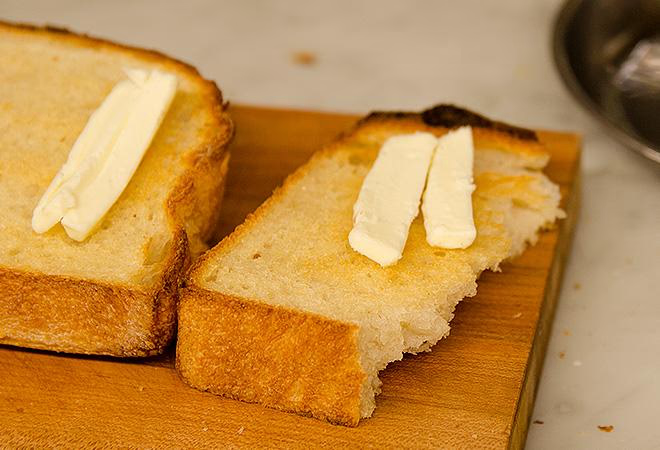
ごはんのおかずがたくさんあるように、食パンの食べ方もたくさんあっていいんだと思います。バターを塗ってもジャムを塗っても、お惣菜をのせても、もちろんそのままでもおいしく食べられるかまパンの食パン。神山に訪れたらぜひ味わっていただきたいです。
(かま屋のモーニングでもトーストセットが食べられます。)
もうひとつの「日常」。
コッペパン。
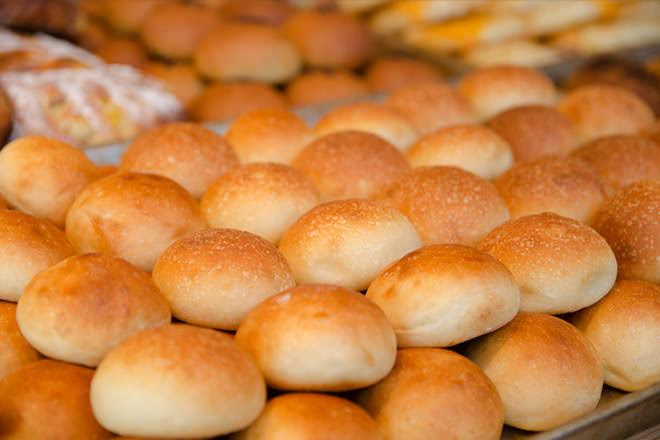
コッペパンは一個50円
東の横綱が食パンだとしたら、西の大関がコッペパン。
あんこでもコロッケでも包み込めるコッペパンは、まさに日常のパンです。
かまパンのコッペパンは、ふんわりさっくりして軽やかさがあります。かたちもコロコロして、ついつい親しみがわいて来る…。ずっしり重たい食パンとは対照的な存在です。
かまパンのコッペパンで使われる種は「イースト」と「自家発酵培養種」。
イーストは余計な味がしない分、粉の味を楽しめる種で、ふくらむ力が強く、やわらかいパンやさっくりしたパンに向いています。
「実は今のかたちのコッペパンができあがったのは、オープニングレセプションの2日前なんです。」
かまパンらしい、ライブ感あふれるコッペパンができるまでのエピソードを、笹川さんが語ってくれました。
「料理長から『コッペパンはお惣菜を挟むから、もう少し軽くできないかな?』と言われたんです」
「バターや卵いれたら解決できちゃう?」と考えた笹川さん。
通常はバターや卵を使うことも多いそうですが、食事として毎日食べられるパンを目指しているかまパンでは、できるだけシンプルな材料を模索していました。しかし、妙案はみつからず…。
「もう、ネタ切れだ…」
そんな中やってきたオープニングレセプション2日前の3月1日 。
それまでコッペパンはオリーブオイルを使っていましたが、その日、たまたま在庫が切れてしまいました。
そのとき、料理長がオープニングレセプション用に米粉と米油を使ったマフィンを作っていたのを思い出し、笹川さんはひらめきます。
「これ、米油でつくれないかな?」と。
オリーブオイルの代わりに米油を使ってみた結果…。
「きたんじゃない?!」
ふわふわでさくさくなコッペパンが焼きあがりました。
こうしてオープン直前、かまパンのコッペパンができあがったのです。
コッペパンの生地は、他にもいろんなパンに使われています。サンドイッチ(あんバター)、カレーパン、さつま芋ローフ…。コッペパンの生地はまさに変幻自在。いろんな形のパンになって、毎日お客様をむかえています。
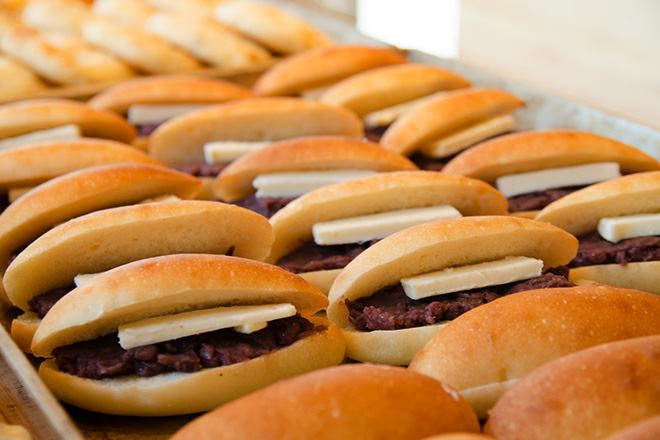
みんなが大好きあんバター280円(税抜)。あんこは現在、地元の和菓子屋さんに作ってもらっています。
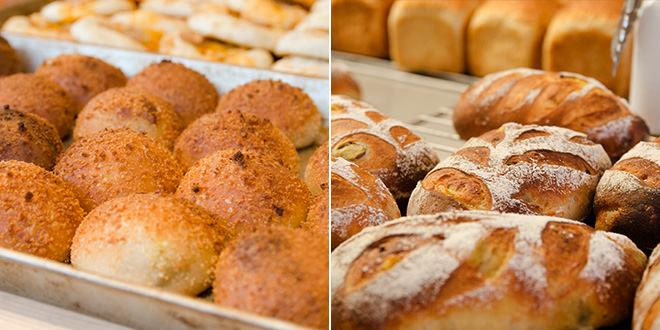
左)カレーパン250円(税抜)。かま屋を切り盛りする料理長が、前日にカレーのあんをつくってくれたもの。
右)さつま芋ローフ400円(税抜)(季節限定商品。2017年5月現在はよもぎローフに)。大人気のさつま芋ローフだったが、実はこれも試行錯誤しながら作られたパン。最初は食パンの生地で作られていたが、食パンの型が足りなかったため、型のいらない今の形に。食パンの生地ではこの形に成型するのが難しかったので、コッペパンの生地で試したら、芋の水分をほどよく生地が吸収し、ちょうどよいもっちり感のあるパンとなりました。
夜明けとともにすくすくと、
「神山のパン」が焼かれていく
パン屋さんの朝は早い。
かまパンも朝の5時からはじまります。
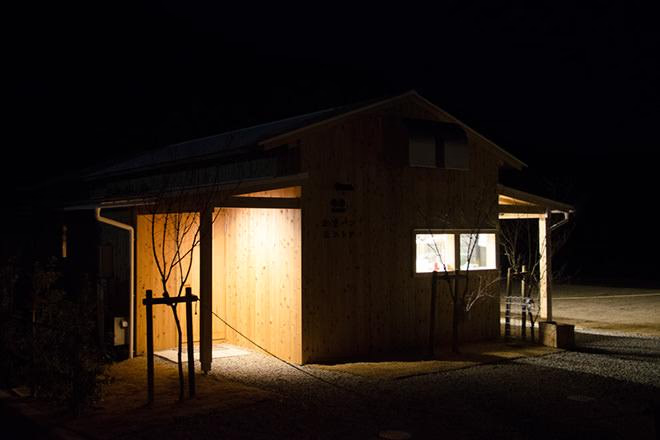
朝5時のかまパンの外観。夜明け前にポツンとあかりが灯っています
仕込みのはじまる時間からお邪魔してもよいでしょうか?
取材前日、笹川さんに伺うと、
「いいですよ。塩見さんとぼくで、朝の儀式をやってると思います」
という返事が。
儀式ってなんだろう・・・。
とても気になる・・・。
取材よりも「儀式」が気になり、朝の5時に何が起きるのか、気もそぞろに工房に向かいました。
すると、
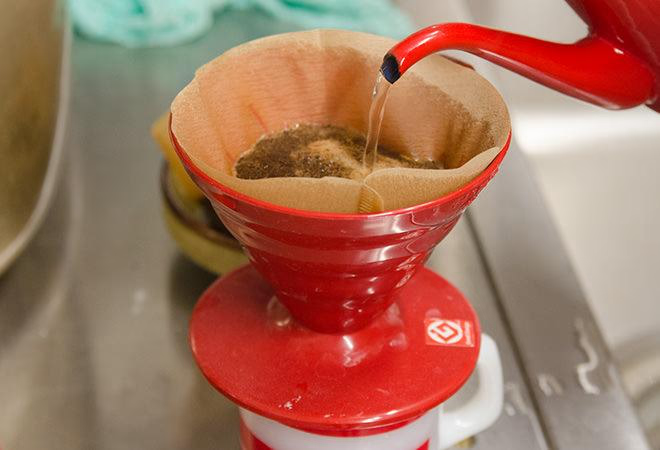
コーヒーを淹れてました。
濃いのに苦味がさらっとしている、後味がフルーティーな、なんとも絶妙なバランスのコーヒーです。
笹川さんが八王子にあるお気に入りのお店の豆を取り寄せいているのだそう。
「なんて名前のお店ですか?」
「かざあなコーヒーです」
「風穴?」
風穴ではなく、kazaana coffee(カザーナ コーヒー)。「カザーナ」 とは ウルドゥ語で 「宝物」 の意味。
コーヒー豆を手で挽き、丁寧にドリップしたコーヒーを淹れるのが、かまパンの1日がはじまる「儀式」でした。
パン屋さんの1日はとても忙しいです。
朝の5時から閉店まで、ずっと立ちっぱなしで、パンを作り続けます。
「お昼はやっぱりかま屋のみんなで食べたいなぁ。おいしいご飯食べるのは大事。
14時にみんなでご飯食べられるシステムをつくるのが、直近の目標です 」
そんな忙しすぎるパンのつくり手たちが朝の5時に淹れるコーヒーは、かけがえのないものに感じました。
さて、かまパンは、これからどんなパン屋さんに進化していくのでしょう?
これからやりたいことはなんですか?と笹川さんに伺うと、
「ライ麦パンをつくりたい」
という答えが。
笹川さんが「絶対にやります」と言うと、塩見さんも「絶対にやります」と重ねてきました。絶対に。
去年の10月からフードハブでは小麦を育てています。
その収穫に合わせて、カンパーニュ(食事によく合うハード系のパン)も作ろう、という話もあるようです。神山産の小麦からつくる、より産食率の高い「地産地食」のカンパーニュができる日も遠くないかもしれません。
まだ見ぬライ麦パンやカンパーニュが、神山の「日常」になることができるのか。
これからもかまパンでは実験的な試行錯誤が続いていくことでしょう。
朝のコーヒーの儀式から1時間ほど。東に向いた工房の窓からは、昇りはじめた陽の光で、目の前の芝と山の輪郭が徐々に浮かび上がってきました。
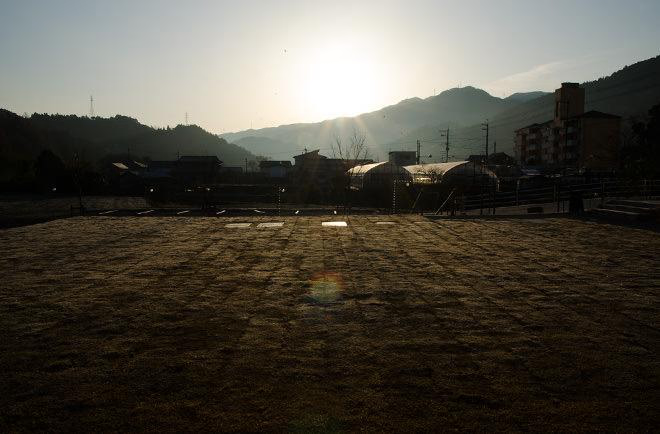
「みえますか?この瞬間がすごい好きなんんです」
窓の外を眺めながらパンをこねる塩見さんと笹川さん。
昇りはじめた太陽の光で、目の前の芝の輪郭が徐々に浮かび上がってきていました。
「だいたい山をみてるんです」
そう言う笹川さんは嬉しそう。
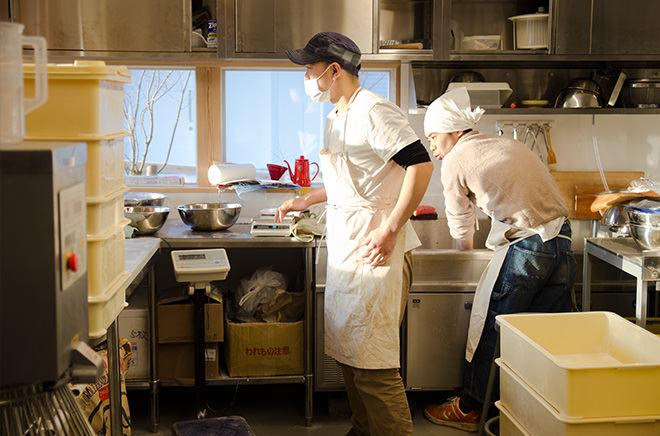
太陽が昇ると、なぜかそろって上着を脱ぎ始めたふたり。陽の光をあびて活力もみなぎってくるようです。
神山の空気を吸い込みながら息づいている自家培養種とともに、パンの作り手たちも神山の自然を感じながらすこやかにパンを作っている。
かまパンの工房の朝はこのようにはじまり、日々営まれています。
一緒に息づきながら育っていくパンと人。
少しづつ神山の日常に根ざしながら、まだまだ進化しようとしています。
その進化が一体どんなところへ向かうのか、今後もかまパンを追っていきたいと思います。
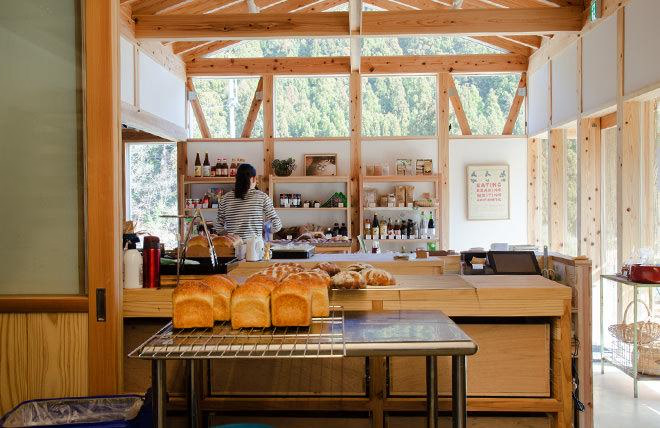
厨房から見た店内のようす。山の木々に包まれているかのようなそこは、つくり手さんにしか見えないとっておきの風景です。
「イースト」「天然酵母」という言葉の定義について
この記事では「イースト」「天然酵母」という言葉が多く出てきますが、これは「人工」「天然」の対比の意味ではありません。イーストとは、もともと自然界に存在した野生酵母の中から製パンに適した酵母のみを抽出し、純粋培養しているものです。よって、酵母に「天然」「人工」という区分けはありません。誤解をまねくために最近ではイーストのことを「パン酵母」と呼びはじめていますが、この記事では読みやすさを重視し、一般的に流通した「イースト」「天然酵母」という言葉をつかわせてもらいました。
かまパン&ストア
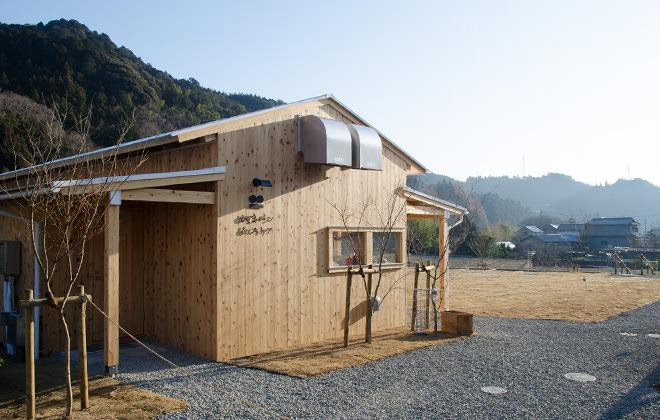
住所 徳島県名西郡神山町神領町190-1(GoogleMap)
営業時間 9:00 – 18:00
定休日 月+火(月祝の場合営業)
電話 088-676-1077
